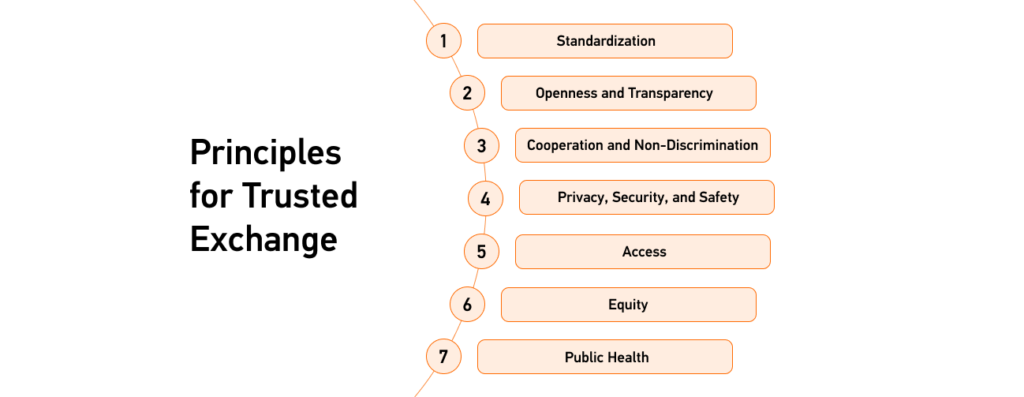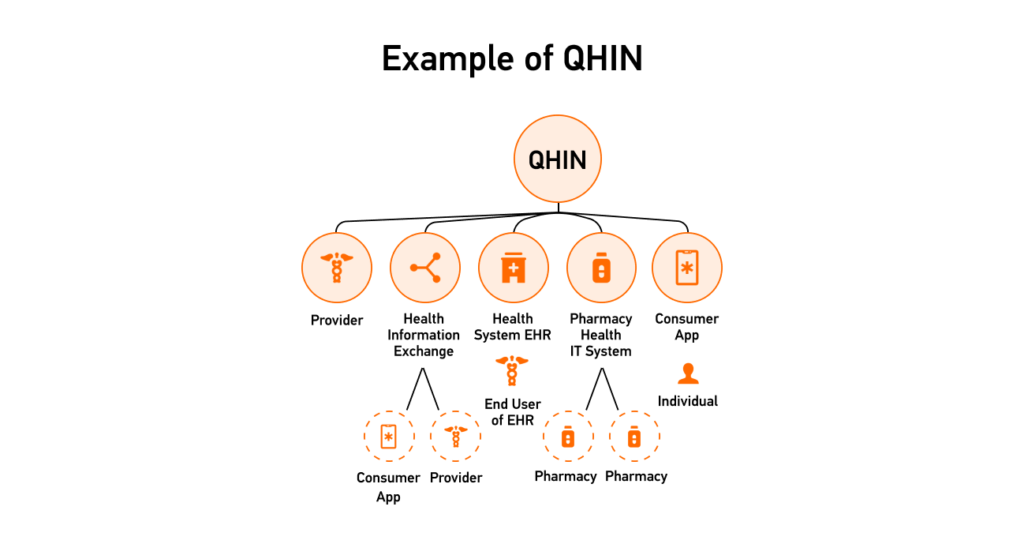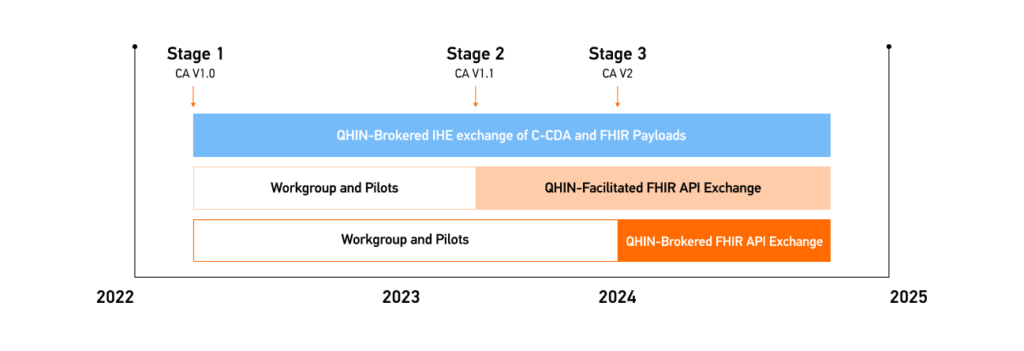Incorporating advanced information technology solutions helps improve operational efficiency and the quality of care within the healthcare sector. This transition towards extensive implementation and use of health IT solutions across the US is led by public bodies such as the Office of the National Coordinator for Health Information Technology (ONC).
On January 19, 2022, ONC introduced the first version of the Trusted Exchange Framework and Common Agreement (TEFCA), designed to facilitate the seamless exchange of information nationwide. Let’s discover the impact of TEFCA on healthcare.
What Is TEFCA: Principles, Components, and Technical Framework (QHIN)

1. Standardization: Health Information Networks (HINs) should prioritize federally recognized and industry-acknowledged technical standards, policies, best practices, and procedures for building a cohesive and efficient exchange ecosystem.
2. Openness and Transparency: HINs should run their activities transparently, promoting stakeholder trust and fostering a collaborative environment.
3. Cooperation and Non-Discrimination: HINs should collaborate across the continuum of care, setting aside competitive attitudes to ensure the seamless electronic exchange of digital health information.
4. Privacy, Security, and Safety: The exchange of digital health information should be conducted with the utmost consideration for privacy, data security, and patient safety.
5. Access: HINs should facilitate and promote a clear understanding of how the information has been used or disclosed while adhering to civil rights obligations on accessibility.
6. Equity: HINs should consider the diverse impacts of interoperability on different populations and throughout the entire lifecycle of the activity, ensuring an inclusive approach.
7. Public Health: HINs should extend their support to public health authorities and population-level use cases to help develop a learning health system, ultimately improving the population’s health and reducing the cost of care.
These principles lay the base for a robust and effective health information exchange, emphasizing technical aspects and ethical considerations for building a patient-centric healthcare system.
The Components of TEFCA
TEFCA is a set of rules that helps healthcare organizations securely share patient information, which functions through four components:
- The Trusted Exchange Framework (TEF): Principles for Trusted Exchange
- Common Agreement for Nationwide Health Information Interoperability
- Standard Operating Procedures (SOP)
- The Qualified Health Information Network Technical Framework (QTF)
Enacted through the 21st Century Cures Act, the Trusted Exchange Framework (TEF) is a directive for the National Coordinator to establish a secure health information exchange infrastructure. The TEF provides foundational principles for trust policies and practices for the exchange between Health Information Networks (HINs), facilitating efficient contractual relationships and promoting the electronic flow of digital health information.
The Common Agreement establishes a robust technical infrastructure model and governing approach to foster the secure exchange of clinical information among diverse health information networks and their users. Its inclusive framework extends advantages to various entities, encompassing health information networks, ambulatory practices, hospitals, health centers, federal government agencies, public health agencies, and payers. Individuals can also leverage the Common Agreement to access their health information through entities offering individual access services.

TEFCA’s Standard Operating Procedures (SOP) outlines the structure and governance of the Governing Council and the Council’s composition, including TEFCA’s Qualified Health Information Network and Participant/Subparticipant Representatives, along with the RCE Representative. The SOP covers member expectations, leadership appointments, quorum requirements, and terms of service. It also addresses meeting conduct, member suspension, and removal procedures, emphasizing professional standards and fostering effective, transparent, and inclusive decision-making processes.
TEFCA QHIN
The 21st Century Cures Act led to the creation of the Trusted Exchange Framework and Common Agreement, supported by ONC and guided by The Sequoia Project, acting as the Recognized Coordinating Entity (RCE).
The QHIN Technical Framework (QTF), crafted by the RCE, outlines the functional and technical prerequisites for QHIN status. This framework comprises a set of technical components essential for the secure exchange of health information:
- QHIN Query Modality: Technical intricacies enabling targeted retrieval of health information.
- QHIN Message Delivery Modality: Specifications for the secure delivery of health information between QHINs.

These components allow QHINs operational flexibility, harmonizing with their unique business needs. For example, national healthcare groups, such as CommonWell Health Alliance, eHealth Exchange, and Carequality, often use Integrating the Healthcare Enterprise (IHE) profiles like Cross-Community Patient Discovery (XCPD) and Cross-Community Access (XCA) to exchange clinical documents across various healthcare communities. The QTF also acknowledges current variations in patient-matching methods and plans to work with QHINs to create future patient-matching guidelines.
TEFCA and FHIR (Fast Healthcare Interoperability Resources)
HL7 designed FHIR to facilitate the exchange of Electronic Health Information (EHI) in healthcare. However, despite its implementation by some organizations, its widespread adoption in multi-networked environments still needs to be improved. Addressing this gap, The Sequoia Project created the Three-Year FHIR Roadmap for TEFCA Exchange to promote industry-wide FHIR adoption and make stakeholders embrace the future of standards in healthcare.

The roadmap, published by ONC and the RCE, aligns TEFCA with evolving health IT needs, leveraging the current state of FHIR. In 2022, working groups initiated by the RCE explored FHIR use in QHIN-brokered and facilitated exchanges. The planned stages include FHIR Content Support, Network-Facilitated FHIR Exchange, and Network-Brokered FHIR Exchange, progressively integrating FHIR capabilities into TEFCA’s policy and technical infrastructure.
Conclusion
TEFCA suggests FHIR as the tool for establishing interoperability, trust, and efficiency in healthcare. Leveraging FHIR is necessary to ensure the information flows seamlessly, unrestricted by technical constraints, actively contributing to improved workflows and better patient outcomes.
Adopting the principles of TEFCA for healthcare will foster innovation and a collaborative environment within the industry. TEFCA and FHIR provide a clear strategy for exchanging and managing healthcare information.
Collaborating with Edenlab is the best way to harness the full potential of TEFCA and FHIR. Our team of FHIR experts will guide you through the intricate healthcare regulatory landscape, ensuring compliance with industry laws and requirements. Whether you’re starting from scratch or enhancing an existing system, we ensure a smooth FHIR server implementation tailored to your needs. Contact us to integrate FHIR into your system and turn it into an integral part of the healthcare exchange ecosystem.






